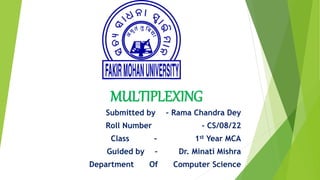
MULTIPLEXING.pptx
- 1. MULTIPLEXING Submitted by – Rama Chandra Dey Roll Number - CS/08/22 Class - 1st Year MCA Guided by – Dr. Minati Mishra Department Of Computer Science
- 2. CONTENT What is Multiplexing ? Why Multiplexing ? History of Multiplexing Concept of Multiplexing Advantages of Multiplexing Types of Multiplexing Frequency Division Multiplexing Wavelength Division Multiplexing Time Division Multiplexing
- 3. MULTIPLEXING Multiplexing is a method of combining and transmitting several data streams across a single media. It is the process in which multiple signals coming from multiple sources are combined and transmitted over a single communication or Physical line. The hardware device which is used for multiplexing is known as a Multiplexer(MUX). Multiplexer combines ‘n’ input lines to generate a single output line. It follows many to one i.e. n input line and one output line. Demultiplexer is a device that separates multiple signals into its component signals. It follows one to many approach.
- 5. Why Multiplexing ? The transmission medium is used to send the signal from sender to receiver. The medium can only have one signal at a time. If there are multiple signals to share one medium, then the medium must be divided in such a way that each signal is given some portion of the bandwidth. If there are 10 signals and bandwidth of medium is 100 units, then the 10 unit is shared by each signal. When multiple signals share the common medium, there is a possibility of collision. Multiplexing concept is used to avoid such collision.
- 6. History of Multiplexing Multiplexing originated in telegraphy in the early 1870s and is now widely used in communication. George Owen Squier developed the telephone carrier multiplexing in 1910.
- 7. Concept Of Multiplexing The ‘n’ input lines are transmitted through a multiplexer and multiplexer combines the signals to form a composite signal. The composite signal is passed through a Demultiplexer and demultiplexer separates a signal to component signals and transfers them to their respective destinations.
- 8. Types of Multiplexing Multiplexing Frequency Division Multiplexing Wavelength Division Multiplexing Time Division Multiplexing Synchronous TDM Asynchronous TDM
- 9. Frequency Division Multiplexing Frequency Division Multiplexing is an analogue technique that divides the available bandwidth of a single transmission medium into several channels. Modulation methods are used to convert the input signals into frequency bands, which are then merged by a multiplexer to produce a composite signal. Here, there are 3 devices which sends analogue signals to the multiplexer through modulator with the help of transmission media. By the multiplexer device, signals are combined to form composite signals. The carriers which are used for modulating the signals are known as Sub-carriers. They are represented as f1,f2,…fn.
- 10. Frequency Division Multiplexing With the help of Demultiplexer, the composite signals are sub-divided into different frequency channels and allocate them to different respected devices. This technique is widely used in Telecommunication networks, Wireless Networks, FM radio etc.
- 11. Frequency Division Multiplexing Advantages It is used for analogue signals. FDM process is very simple and easy modulation as compared to other multiplexing system. A large number of signals can be sent through the FDM simultaneously. It does not require any synchronization between sender and receiver. Disadvantages FDM technique is used only when low speed of channels are required. It suffers the problem of crosstalk. A large number of modulators are required. It requires a high bandwidth channel.
- 12. Wavelength Division Multiplexing Wavelength Division Multiplexing is similar to FDM except that the optical signals are transmitted through the fibre optic cable. It is used to utilize the high data rate capability of fibre optic cable. Optical signals from different source are combined to form a wider band of light with the help of multiplexer. At the receiving end, demultiplexer separates the signals to transmit them to their respective destinations. Multiplexing and demultiplexing can be achieved by using a prism. Prism can perform a role of multiplexer by combining the various optical signals to form a composite signal, and the composite signal is transmitted through a fibre optical cable. Prism also perform a reverse operation i.e. demultiplexing the signals.
- 14. Wavelength Division Multiplexing Advantages With the aid of WDM, several signals may be sent at the same time. This method is less costly, and system expansion is simple. This method is highly secure. Because optical fibre is used in WDM, optical components are more dependable and provide more bandwidth. Disadvantages Because optical equipment is used, the cost rises. Because of poor bandwidth use, wavelength adjustment might be challenging. This technique’s major issue is scalability.